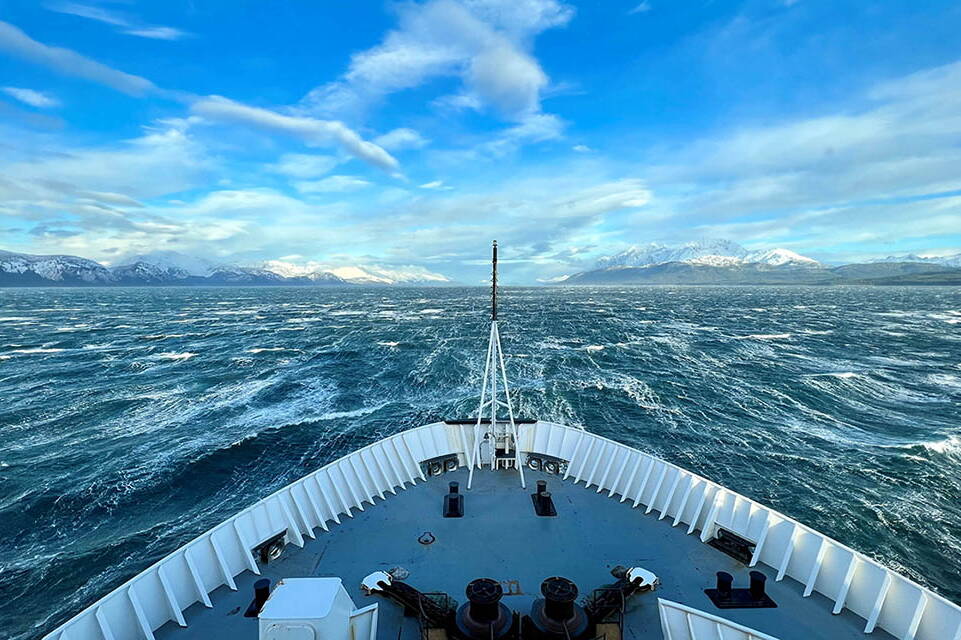Crew shortages continue to plague the Alaska Marine Highway, the ferry system’s director told a gathering of Southeast officials last week.
“Our biggest shortage is in the engineering department,” where the 54 ship engineers on the payroll as of Jan. 26 were far short of the 81 needed for full staffing, Craig Tornga told a gathering of community, business and government leaders at the Southeast Conference on Feb. 7 in Juneau.
“We’re short in the wheelhouse,” he added, down eight from a full contingent of 79 in the master, chief mate, second- and third-mate positions.
The update occurred a week before a state-hosted job fair for the ferry system, scheduled from noon to 5 p.m. Tuesday at the Mendenhall Valley Public Library.
Tornga, who was hired last March, inherited the challenge of bringing crew levels back to full staffing. A lack of crew has forced the ferry system into paying overtime and canceling sailings to manage operations.
“We still have the same crewing challenges,” he said.
As of Jan. 26, the system was short about three dozen workers — not counting stewards, cooks and other similar lower-level positions.
“This entry-level-pay position has a very high turnover rate,” Tornga said of stewards. “Presently, we are experiencing a shortage of cooks, which is…affecting operations.”
Despite recent improvements, the system lost more mates, pilots and engineers than it hired in 2023. The licensed engineers are responsible for a ship’s propulsion system, most machinery and the safe operation of mechanical systems aboard the vessel.
The state-operated ferries have been short of crew since losing trained workers to retirement, resignation and furloughs during deep cuts in the operating schedule amid the worst of the COVID-induced collapse in travel, which coincided with steep cuts in state funding.
When the ferries tried to resume pre-COVID schedules in 2022 and 2023, the system was unable to hire enough new crew members to staff all the vessels.
From 2019 through early 2022, the ferry system lost 155 more employees than it hired, management told legislators in 2022. In May 2022, 60% of the Alaska Marine Highway’s jobs were vacant, the highest vacancy rate among any state agency.
The state has improved its hiring numbers of late, Tornga said, and recruiters continue to go after new hires from marine academies nationwide and at career days at Alaska high schools.
“The hardest sell is to get them to come to Alaska,” he said of recruiting from maritime academies. “We find we retain Alaskans at a better percentage than out-of-state hires.”
Unless more crew members are hired soon, the Kennicott will spend its second summer tied to the dock in Ketchikan, unable to put enough workers on board to meet U.S. Coast Guard minimum staffing levels.
The ferry system is not the only state agency dealing with a worker shortage.
As of December, state job positions with the highest vacancy rates included unemployment benefit workers (37.7%), public health nurses (33.3%), emergency services dispatchers (27.3%), and child support specialists (24.3%).
Tornga also updated Southeast Conference attendees last week on the upcoming summer schedule and work plans to upgrade or repair several vessels.
The LeConte will be delayed coming back to service in May from winter maintenance after workers found “rotten steel” on the ship and had to schedule more time in the shipyard for additional repairs, he said.
The Alaska Marine Highway expects to go to bid in March to add sleeping quarters for crew to the Tazlina, which has seen limited service since its launch six years ago because it cannot run more than 12 hours without a second crew on board.
A major upgrade to the controllable-pitch propellers system will take the Columbia, the mainstay of service between Southeast Alaska and Bellingham, Washington, out of service for a period in 2025.
Also in 2025, the state plans to upgrade the generators aboard the Kennicott to reduce air emissions to meet federal standards, Tornga said.
The 61-year-old Matanuska, the oldest vessel in the fleet, remains out of service for the second year until “we can get it in the air and take a look at the double bottom” to check for rusted steel plates, he said.
After management has more information on necessary repairs and costs, the state can make a decision whether it is worth it to do the work to put the ship back into operation, Tornga said.

